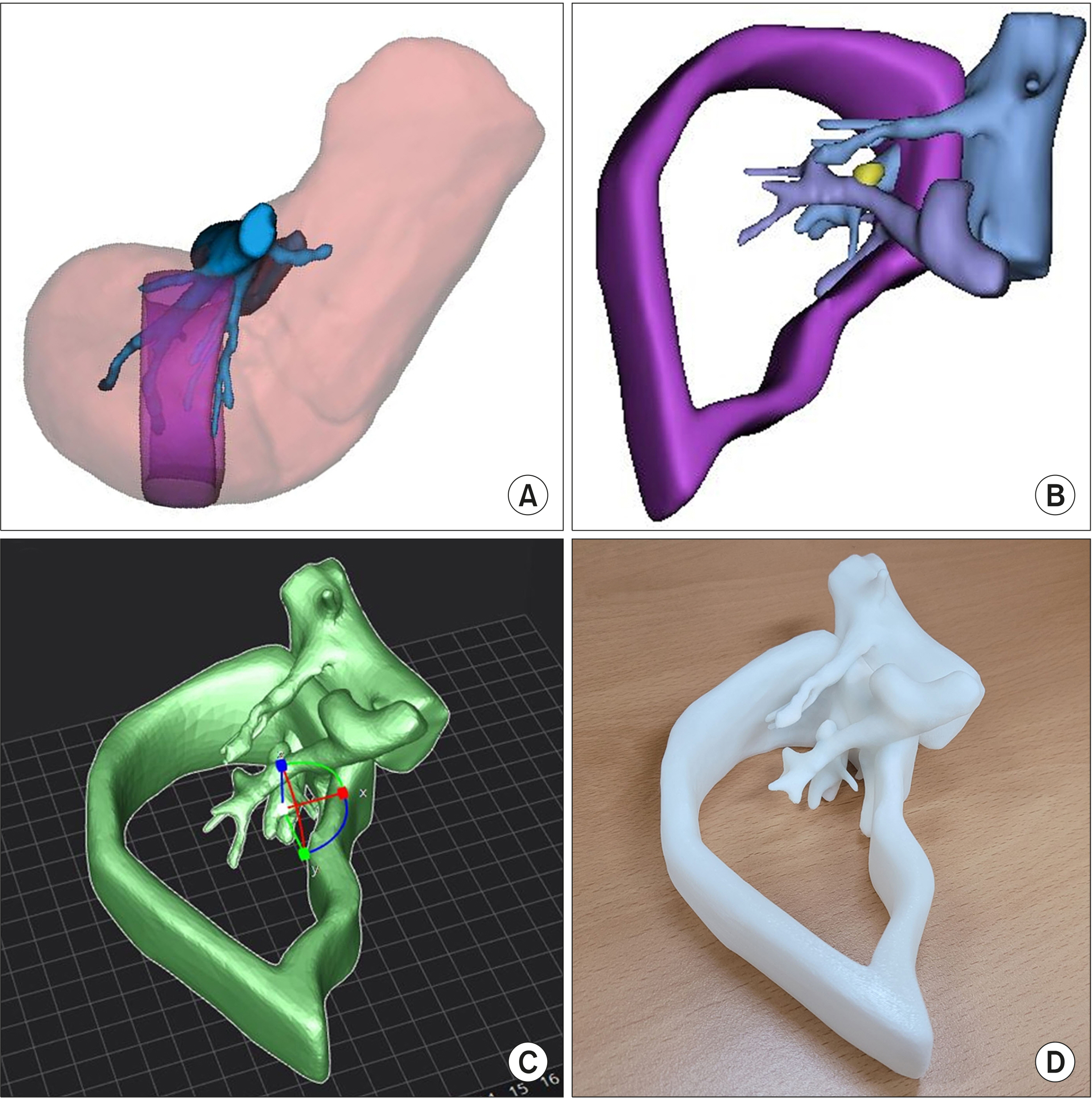Ann Hepatobiliary Pancreat Surg.
2021 May;25(2):265-269. 10.14701/ahbps.2021.25.2.265.
Application of three-dimensional printing for intraoperative guidance during liver resection of a hepatocellular carcinoma with sophisticated location
- Affiliations
-
- 1Department of Surgery, Samsung Medical Center, Sungkyunkwan University School of Medicine, Seoul, Korea
- KMID: 2516249
- DOI: http://doi.org/10.14701/ahbps.2021.25.2.265
Abstract
- While 3D printing is adapted usefully in certain field of surgery, its application in liver surgery was limited. Here, we introduce our experience for using 3D printing for intraoperative guidance during liver resection in a case for HCC with an intrahepatic metastasis at a sophisticated location. A 50 years old male patient was diagnosed 4.7 cm-sized hepatocellular carcinoma located on segment 3 with and an intrahepatic metastasis located on segment 8 which was between right anterior portal vein, middle hepatic vein and right hepatic vein. Since radiofrequency ablation appeared to be inappropriate, surgical resection was planned. However, the patient had a cirrhotic liver and left liver was estimated to be 47% according to volume measurement. Therefore, we planned a two-step procedure by performing left hemihepatectomy preserving the middle hepatic vein and additionally removing the intrahepatic metastasis by tumorectomy. For better guidance, we made a 3D printed model tailored for using it as a guidance during operation, and the accuracy of 3D-printed model helped the surgical team perform a safe operation. The patient underwent adjuvant proton beam therapy on the site of tumorectomy and did not experience recurrence.
Keyword
Figure
Cited by 1 articles
-
Improved graft survival by using three-dimensional printing of intra-abdominal cavity to prevent large-for-size syndrome in liver transplantation
Sunghae Park, Gyu-Seong Choi, Jong Man Kim, Sanghoon Lee, Jae-Won Joh, Jinsoo Rhu
Ann Hepatobiliary Pancreat Surg. 2025;29(1):21-31. doi: 10.14701/ahbps.24-153.
Reference
-
1. Ercolani G, Grazi GL, Ravaioli M, Del Gaudio M, Gardini A, Cescon M, et al. 2003; Liver resection for hepatocellular carcinoma on cirrhosis: univariate and multivariate analysis of risk factors for intrahepatic recurrence. Ann Surg. 237:536–543. DOI: 10.1097/01.SLA.0000059988.22416.F2. PMID: 12677151. PMCID: PMC1514472.2. Fong Y, Sun RL, Jarnagin W, Blumgart LH. 1999; An analysis of 412 cases of hepatocellular carcinoma at a Western center. Ann Surg. 229:790–799. discussion 799–800. DOI: 10.1097/00000658-199906000-00005. PMID: 10363892. PMCID: PMC1420825.
Article3. Rustgi VK. 1987; Epidemiology of hepatocellular carcinoma. Gastroenterol Clin North Am. 16:545–551. DOI: 10.1016/S0889-8553(21)00328-9.
Article4. Grazi GL, Ercolani G, Pierangeli F, Del Gaudio M, Cescon M, Cavallari A, et al. 2001; Improved results of liver resection for hepatocellular carcinoma on cirrhosis give the procedure added value. Ann Surg. 234:71–78. DOI: 10.1097/00000658-200107000-00011. PMID: 11420485. PMCID: PMC1421950.
Article5. Regimbeau JM, Kianmanesh R, Farges O, Dondero F, Sauvanet A, Belghiti J. 2002; Extent of liver resection influences the outcome in patients with cirrhosis and small hepatocellular carcinoma. Surgery. 131:311–317. DOI: 10.1067/msy.2002.121892. PMID: 11894036.
Article6. Rhu J, Kim SJ, Choi GS, Kim JM, Joh JW, Kwon CHD. 2018; Laparoscopic versus open right posterior sectionectomy for hepatocellular carcinoma in a high-volume center: a propensity score matched analysis. World J Surg. 42:2930–2937. DOI: 10.1007/s00268-018-4531-z. PMID: 29426971.
Article7. Louvrier A, Marty P, Barrabé A, Euvrard E, Chatelain B, Weber E, et al. 2017; How useful is 3D printing in maxillofacial surgery? J Stomatol Oral Maxillofac Surg. 118:206–212. DOI: 10.1016/j.jormas.2017.07.002. PMID: 28732777.
Article8. Witowski JS, Coles-Black J, Zuzak TZ, Pędziwiatr M, Chuen J, Major P, et al. 2017; 3D printing in liver surgery: a systematic review. Telemed J E Health. 23:943–947. DOI: 10.1089/tmj.2017.0049. PMID: 28530492.
Article9. Kuroda S, Kobayashi T, Ohdan H. 2017; 3D printing model of the intrahepatic vessels for navigation during anatomical resection of hepatocellular carcinoma. Int J Surg Case Rep. 41:219–222. DOI: 10.1016/j.ijscr.2017.10.015. PMID: 29096348. PMCID: PMC5683889.
Article
- Full Text Links
- Actions
-
Cited
- CITED
-
- Close
- Share
- Similar articles
-
- Virtual Surgical Planning and Three-Dimensional Printing for Reconstruction of Mandibular Defect by Fibula Free Flap: A Case Report
- Comparative analysis of intraoperative radiofrequency ablation versus non-anatomical hepatic resection for small hepatocellular carcinoma: short-term result
- Application of Three-Dimensional Printing in the Fracture Management
- Clinical Application of Three-Dimensional Printing Technology in Craniofacial Plastic Surgery
- Surgical Perspectives of Hepatocellular Carcinoma beyond the Barcelona Clinical Liver Cancer Guideline; Focusing on Liver Resection




